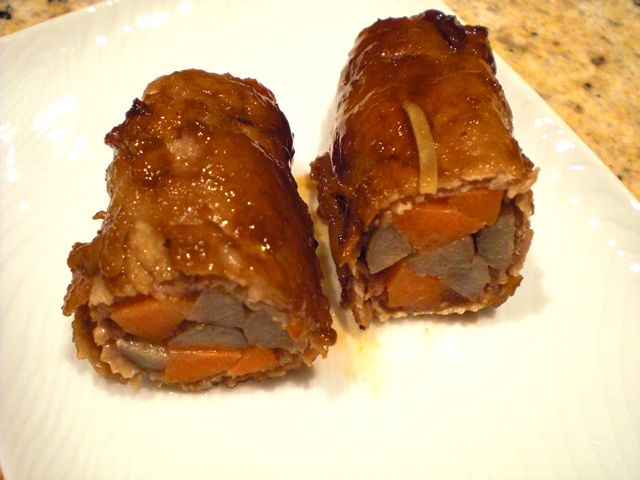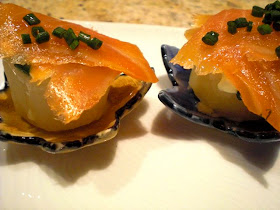When I think of
Sukiyaki, it conjures up two unrelated memories in my mind. One is a Japanese popular song called "Ue-o muite arukou" "
上を向いて歩こう"; translated into English, as "Let me gaze up while I am walking (and holding back my tears)". This was sung by
Kyu Sakamoto 坂本九, who was later killed in
a tragic commercial airplane crash in 1985. This is a melancholic song without any reference to food but, for some reason, was named "
sukiyaki" when it was introduced to the U.S. The lyrics of the song and this English title have absolutely no relation to each other whatsoever except that both were from Japan--it is the equivalent to introducing "
Moon River" as "
Beef Stew".) Despite this, it was reportedly #1 on the Billboard magazine hit chart in June 15 of 1963.
Sukiyaki also reminds me of the very first time my wife and I visited Kyoto together so many years ago. Although we had visited Japan frequently we usually headed straight to Hokkaido occasionally staying only a few days in Tokyo. So the Japan my wife knew consisted of only Tokyo, Sapporo and other parts of Hokkaido. For her, Kyoto was an eye-opening experience--until then she thought all of Japan was like Hokkaido and was surprised to see how different it was.
On that trip, one evening, we stolled along a narrow and crooked alleyway in Pontocho 先斗町. Since I did not do good research ahead of time (this was a time way before internet
Tabelog and food blogs), we did not have any idea which restaurant we should try. Then, I found what appeared to be an old Kyoto house with a small wooden sign saying "Sukiyaki". Although it looked more like a residence than a restaurant, I made an executive decision and we went in. As we said "hello" or "konbanwa" at the small and deserted "genkan" 玄関 entrance, a kimono clad "nakai" san 仲居さん or waitress, came out from behind the sliding "shoji" screen and greeted us. After removing our shoes, we were ushered up into a large Japanese room (10 tatami-mat room or 十畳間) upstairs which was just for us. We did not see any other customers and the "nakai" san made conversations with my wife (through my translation) and I while preparing sukiyaki at the table. It was such a different and pleasant eating experience. The room was elegant in a slightly shabby chic. It was so quiet and peaceful after the bustle on the streets below. I do not remember exactly but it was not outrageously expensive. (In later years, we visited Kyoto many more times. Every time we visit Pontocho, we see that the stores in the alleys have changed and new (chain?) restaurants and girly bars have started replacing old traditional restaurants and drinking places. Although we tried, we were not able to find our "sukiyaki" restaurant again. That meal turned out to be one of those poignant but fleeting experiences--kinda like the song.
This dish, sukiyaki, was invented after the Meiji restoration (1868) when Japanese adapted to eating meat (beef) and also is one of the Japanese foods accepted and popularized in the U.S. long before sushi and sashimi became popular. Sukiyaki 鋤焼 (suki
鋤 means a type of Japanese spades and "yaki" 焼き means to grill or cook. But I am not sure that was how this dish was originally cooked.) has two distinct styles; Kansai 関西 (includes Kyoto) and Kanto 関東 (Tokyo) -styles. Mine must be a Hokkaido 北海道 style. Actually, when I was growing up, my mother used to make sukiyaki with thinly sliced pork rather than beef, which was (and maybe still is) common in Hokkaido.
We have not made sukiyaki for ages but I found thinly sliced sukiyaki beef (frozen), which was not as nicely marbled as Japanese beef, at a Japanese grocery store and decided to make sukiyaki. Sukiyaki is traditionally cooked at the table and "the man of the house" is supposedly in charge of cooking and seasoning sukiyaki even though he usually does not cook. A traditional sukiyaki pot or すき焼き鍋 is made of cast iron、round and shallow with folding handles like one you see here.
Ingredients: Besides thinly sliced beef, the most common items include tofu (especially grilled tofu or 焼き豆腐), Konnyaku thread or
shirataki (白滝) (boiled for few minutes in water and washed in cold running water to remove its distinctive (read:awful) smell, shiitake mushroom (I used shimeji here), onion (either regular, thinly sliced, or Japanese "
negi" scallion cut in 1-2 inch long on a slant), some type of greens such as spinach (I used a mixture of spinach and arugula here, which were very briefly blanched). My wife likes the more traditional edible chrysanthemum or
shungiku (春菊)*. As seen on the left in the image below, I arranged the ingredients on a large plate before starting.
(*We love shungiku for its distinctive taste and even tried to grow it without much success. You could occasionally get it fresh at the Japanese grocery store but the availability is sporadic at best.)
Seasonings: You should have your seasonings handy while cooking sukiyaki; soy sauce, sugar, and sake. I do not use a premixed seasoning liquid or warishita 割り下. Just add these seasonings as you add more ingredients; sprinkle sugar, splash soy sauce and then sake. Since this is done by the man of the house, he does not measure anything (right, image above).
Cooking: We did not cook the sukiyaki at the table this time. I placed a sukiyaki pot on the stove on medium low heat. I first melted a bit of butter (or you could use a chunk of beef fat) and spread the beef over the butter. The proper and traditional way of serving sukiyaki, is to season the meat after it has browned with sake, sugar and soy sauce. Then all the diners taste a small portion of this first cooked meat, since this is the only time browned meat was available to taste. (The rest of the beef added later is just cooked in the seasoning liquid). I do not see much advantage in this custom and I cooked everything together as you see on the right in the picture above. The vegetable and tofu exude water but if the liquid is not enough or the seasoning is too strong you could add more sake or dashi. I put on the lid and cooked it for 5 minutes or until the onion was done.
Serving: The classic way is to serve a raw beaten egg in the bowl as a dipping sauce (shown in the second picture above.) (of course, I used
pasteurized shell eggs for this). The egg will cool the suskiyaki and make it taste better for sure. We just had this as a drinking snack rather than a meal with cold sake. This is such a classic dish and even the inferior quality of the beef did not detract.







